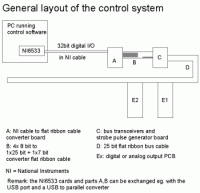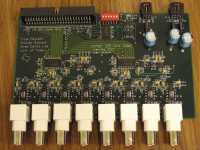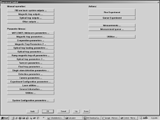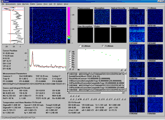A Laboratory Control System for Cold Atom Experiments
![]() You can find the most
up to date version of this project here
You can find the most
up to date version of this project here
We have developed a powerful yet inexpensive and easy to construct experiment
control system. The construction of the system together with the control
software is described here. All circuits and software are free to download and
use for nonprofit. The system was developed for the BEC (Bose-Einstein
condensation) experiments in the
group of Mark Raizen at the University of Texas at Austin and is based on a
system that one of the authors developed previously for experiments at the
Ecole Normale Superieure in Paris.
The hardware here includes a design for analog outputs (16-bit DACs) and digital
outputs on a general purpose parallel bus which is easy to expand upon and
interface with a variety of devices (i.e. DDS devices, microprocessors, etc).
The hardware outputs are laboratory friendly with BNC-type outputs and line
drive capacity. The software is intended for cold atom experiments and contains
the code to talk with the hardware developed here. This system represents a
simple to understand and cost effective method to control laboratory experiments.
Overview - Advertisement (pdf)
A one page hardware and software overview is given here.
Hardware
Here, we show an overview of the hardware implementation that we currently use. This setup involves an NI6533 card from National Instruments for allowing the computer to talk to the output hardware. The manual below suggests other (cheaper, cooler) methods to do this which we have not used since we already had the NI card.
Photos of our analog output boards and digital output boards. Ideal for laboratory electronics.
Hardware Manuals and layouts:
-
National instruments cable to flat ribbon converter board layout (pdf), this is part A above.
-
Bus System Manual and layout (pdf): Description of the hardware of the parallel bus system. Contains schematic and layout for strobe pulse generator board.
Analog Output Design Manual (pdf), Layout (pcb123 file): 16-bit Digital-to-Analog (DAC) converter design to be used with the parallel bus system. Eight analog channels per board, each has a 1/4 Amp line driver and -10 to +10 Volt range.
Digital Output Design Manual (pdf), Layout (pcb123 file): 16 buffered line driver digital outputs per board.
Layout Software: pcb123 Free software from the board maker. To place orders with PCB123, you just download the layout software, load the layout file and place the order from the software through the internet. Generally, when making single boards, we have etched them ourselves with the various PCB supplies from circuitspecialists.com. This we did for the converter board from the NI card, the transceiver and strobe bit generator board, etc.
Software
The experiment control system (15MB) (Rubidium experiment version) (Natrium experiment version (15MB)) (Clean version to start with (15MB)) for download here was devised for the Rubidium and Natrium Bose-Einstein condensation (BEC) experiments in the group of Mark Raizen, but can easily be adapted to many other cold atom experiments. It is a completely rewritten and improved version of the control programs used in the Lithium and Helium experiments of the ENS group in Paris. The design objective is to give the user a simple but very powerful programming interface to implement the sequence of a BEC type experiment. The program is written in Visual C++. The program communicates with a data acquisition computer, running the latest version of the data acquisition program "Vision", over TCP/IP. This second computer is responsible to acquire image data and treat and store them together with the experimental parameters.
To use the control program it is not necessary to use Vision. Any other type of data acquisition program can be used, or for very simple experiments, Control itself can acquire the data. Read the manual to get more information about this program, which would certainly be very useful for any BEC experiment. Here you can look at some screenshots. The menus are automatically generated in dependence of the outputs, parameters and utilities that the user has defined and could look very different for you application. Main menu, Output list, Parameter Menu, Utility Menu, Measurement Menu (interactively created when using program), Measurement Menu (form to create new measurement), Measurement queue (interactively created). The control program can be used with many different types of input/output systems, not only our homegrown proposed here. It comes ready with support for NI6533 and NI6733 cards and it is not too difficult to support other types of output hardware.
Vision2 (7 MB) is the latest version of the image acquisition, data treatment and management program that I wrote for the ENS Lithium project and the Raizen BEC experiments. It is easy to adapt to any camera system and well suited for many atom optics experiments, especially Bose-Einstein condensation experiments. Feel free to download, modify and use the code as you like as long as you notify me and don't sell the program or programs using my code. The working principle of Vision is the following. You should use one computer controlling the experiment and a second computer for image acquisition. The first computer controls the second by serial port (or TCP/IP).
Absorption images are taken and stored together with the experimental parameters. The images are treated and adequate fits are performed. The results are stored in a Origin compatible ASCII file and displayed. Measurement series varying one or several parameters can be stored, added and displayed. Click on the above image to see an enlarged version of the Vision window. The code together with some sample data can be downloaded. Don't forget to read README.TXT in this package. You need Borland C++ 5.02 to modify the program. The program supports Princeton, Apogee and Andor cameras and it is not difficult to support additional cameras. It also supports communication with an independent camera computer via TCP/IP.
Last modified: March 25, 2004
Authors:Todd Meyrath,Florian Schreck
Atom Optics Laboratory
Center for Nonlinear Dynamics
and Department of Physics
University of Texas at Austin
Title: A Laboratory Control System for Cold Atom Experiments
electronic circuit
Source: www.electronics-lab.com
Published on: 2005-02-03
Reads: 691
Print version: ![]()
Other electronic circuits and schematics from PC related
-
DS1620 based USB Digital Thermometer
-
3-Axis Stepper Controller
-
Casio data logger
-
PC Thermometer V2
-
Reading Data From The Parallel Port
-
An Improved Infrared Receiver with Status LED
-
A Worked Stepping Motor Example
-
RS-232 Laser Transceiver
-
Simple Analog to Digital Converter
-
IrDA interface for your mainboard





